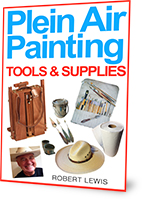There’s a lot to remember when you are out there painting but here’s the best short list you can tuck away in your mind or print out and take with you. It’s like a checklist you can use on location…
- Simplify
The landscape is complicated. You will need to leave a lot of the details out. Look for the big shapes first, block them in, add the most details to the center of focus. - Find the center of focus
Ask yourself what is the most important area of the composition, the center of focus, the place where you want the eye to go to, the real subject of the painting. - Stand back, walk away
Working on a canvas closely for a period of time creates a distorted view of the work. Stand back now and then. Walk away from the easel several feet and look at the canvas. You should be able to spot areas that need correction or more detail. If you want to find an error in your composition quickly, try looking at it in a mirror. The reversed image makes the eye go directly to any flaws. It’s another way of standing back. - Add more colors
The building you are painting might be blue but that doesn’t mean it is only blue. Try adding different blues or even different hues. This will enliven the color space. - Add more paint
After the initial colors are in place thinly. Add more paint in varying hues over the thinner paint. This is what is called “fat over lean”; thicker paint is added over the underpainting thin layers. Adding fat over lean is something you do toward the end of the painting session. It is part of finishing the painting. So don’t start there, end there. - Make sure the center of interest remains the center of interest
You chose the center of interest, what the painting is really about, now look again to see if the supporting areas are too much competition for the focus. If they are, soften their focus. - Focus/Out of Focus
The center of focus should be IN focus sharply, the rest of the painting should be less and less in focus the farther away the eye travels from the center of focus. You are telling the viewer what to look at. - Hot/Cold colors
Aside from a general balance of colors within the canvas, use hotter and colder mixes of a single color to enrich an area of color. A simple color area such as a cloudless sky becomes enlivened when warmer and cooler tones are added. - Big brushes in support areas
Use bigger brushes on the areas that are not the center of focus. these are the areas that support the focus of the painting. Using somewhat larger brushes will force these support areas to be less focused. - Small brushes on focus
In the center of focus use smaller brushes and sharper lines. - Make your brushwork interesting
Juxtaposing angles of brush strokes, putting smooth strokes next to rough strokes, varying the types of brushes used, and even including a bit of palette knife work will make your surface more interesting. - Finish the painting
Don’t pack up your gear yet. Take a Mandatory Deep Breath and then spent plenty of time at the end adding sparkles, checking for errors, and correcting color. You don’t want to look at the painting after it has dried and realized you had not taken the time to really finish it.
All content on this site is © 2015 Robert Lewis. All Rights Reserved. This intellectual property is strictly protected. Do not use without written permission from the copyright owner.







good list Robert! Hope to see you out there!
Thanks, Maggie.
Robert- spot on, as usual!
Thank you, Carole.